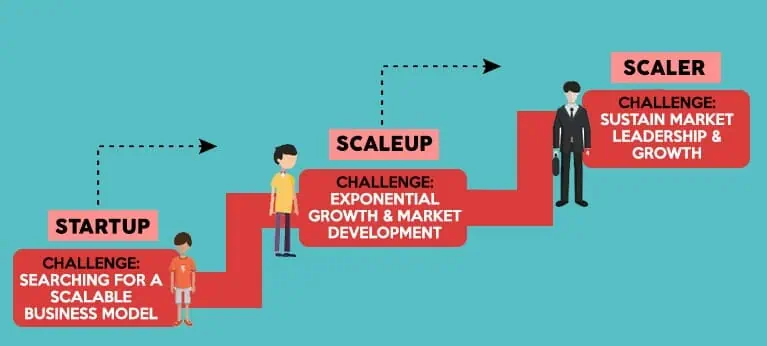Updated on 29/03/2023
When you first start working in the tech industry, you'll quickly be introduced to a whole new set of terms. You may be unsure what the phrases startup and venture capital imply, as well as terms like bootstrapping and MVP. You may even be unsure what the term tech company means.
Scaleup is an example of a term that is gaining in popularity. While startup culture is still a hotbed of creativity, new ideas, and fascinating tech talent, scaleup companies are the ones you're more likely to have heard of.
What Is A Scaleup?
Scaleup company or scaleup is a unique stage of business development. It's a company that's accomplished a lot, had some notable successes and is now poised to take things to the next level.
Scale-up for a company typically means expanding its operations to accommodate increased demand, revenue, or customer base. This can involve growing its team, developing its product or service offering, enhancing its organizational structure, and focusing on long-term growth and sustainability. It may also require adapting to market changes and staying agile in response to customer needs and competition. Essentially, scale-up involves taking a successful business model and replicating it on a larger scale, with the goal of increasing profitability and market share.
When a firm is raising money to fuel its expansion, it is considered a scaleup if it has completed its first round of funding and has reached the Series A stage or comparable. When a firm grows by reinvesting its profits, a process is known as 'bootstrapping,' it will typically reach the scaleup stage when revenue reaches roughly $500,000.
A scaleup company is essentially a high-growth business. High growth, according to the OECD, is defined as a company that has grown by 20% or more in employment or turnover year over year for at least two years and has a minimum employee count of 10 at the start of the observation period.
A scaleup is ready to use their demonstrated success to scale and develop their firm significantly once it has reached a specific size. The scaleup phase is usually the most rapid and substantial stage of expansion, as well as the most challenging.
As a result, it's critical for scaleups to have the correct amount of support and network in place to help them work through and overcome any challenges that arise during this critical business period.
While it is commonly known that startups require a lot of aid and counsel, a widespread misperception regarding scaleups is that they know everything and don't need any help because of their outstanding degree of success and greater exposure.
There are a plethora of excellent local and national resources for startups looking for assistance, but as a company reaches that key threshold of growth, support choices may become more limited.
As a result, organisations in the scaleup stage must have access to a peer-to-peer support network. Connecting with others who are facing similar issues is extremely beneficial; it not only makes good commercial sense but can also provide much-needed emotional support and confidence for high-achieving founders and executives during a moment of significant transition.
Ways To Move From Startup To Scaleup
A startup and scaleup and two different types of businesses. A scaleup has already established its product in the marketplace and is on its path to accelerating growth, whereas a startup is in the early phases of putting its product into the proper hands and receiving funding. So, how do you make the transition from startup to scaleup?
Determine Whether The Product And The Market Are Compatible
Product-market fit occurs when your solution matches the needs of your ideal consumer and does it better than their alternatives. If you're still in the early stages of your business, you're still testing this fit by fine-tuning your buyer personas, building your actual value proposition, finalising your product or service offering, and establishing a baseline for your key business metrics. A scaleup company has mastered all of this to the point that they can safely execute everything on a greater scale without losing their current niche for the sake of expansion.
Securing Funding And Creating A Consistent Revenue Stream
The prototypical startup is notorious for being cash-strapped. A startup in the SaaS market has either gotten no outside funding or is still in the early stages (Seed round or Series A). Startups are nearly wholly reliant on outside funding, whether it's from a venture capital firm or a bank because they're still developing a solid product-market fit and a consistent income stream.
Scaleups, on the other hand, have progressed to further rounds of venture capital funding (Series B and later) and have begun to generate their own income streams. Scaleup company can go to a larger operation with confidence in their predicted return on investment if they've proved product-market fit and secured funding.
Define Roles And Hierarchies Clearly
Because startups can't afford to hire a whole team at first, their small workforce is obliged to perform in a variety of jobs rather than focusing on a single task. It's time to start shifting away from this strategy when your firm starts to generate more money and hire new staff.
If you want to scale effectively, each employee must be completely focused on one task and one task only. If members of your team are still juggling numerous responsibilities, it will be confusing and inefficient, slowing down your progress. Begin making plans for the future and separating these positions as soon as possible. At the absolute least, sketch out what this modification will look like once it is implemented.
At the same time, the founders or current leadership team can only lead so many employees before it becomes a full-time job for them. Consider additional levels of management and an overarching organisational hierarchy as you plan the transition to specific roles.
Many modern firms advertise a "flat" organisation, which means they don't work with layers upon levels of leadership. This initiative can be scary. A proper scaleup requires some form of management structure so that growth isn't stifled by the necessity for a leadership team to examine each and every action before moving forward.
Create A Tech Stack
Startups might start investing in more technology to help them develop and measure their progress when they obtain more funding and revenue. If you don't manage your marketing funnel and keep an eye on your key business indicators as your company scales up, you'll have more to lose. As a result, you'll need a unified tech stack that can quickly and readily identify your company's weak spots.
Companies' growth strategies include determining their minimal viable tech stack and purchasing only the platforms they absolutely require to scale. Rather than squandering time and money analysing and acquiring every technology that claims to help your business develop, think about what will move your company from startup to scaleup.
Install Automated Or Replicable Systems
You must automate as much as possible in order to fully shift from startup to scaleup. Repetitive duties must be avoided if you want your personnel to be completely focused on accelerating your business.
- Use your marketing automation software to automate the deployment of email nurture campaigns, the transfer of leads to sales, the scheduling of social postings across many accounts, and the optimization of your marketing assets.
- Set up automated withdrawals so you don't have to worry about paying your payments on time.
- Pay your employees on time by automating your payroll procedure.
- Any additional internal procedures should be documented and stored (digitally) where they can be easily accessed so that each one can be replicated across the entire organisation and new recruits know exactly what they're doing right away.
When it comes to new hiring, your onboarding programme is one of the most crucial processes to be able to reproduce. Startups may find it difficult to commit a significant amount of time to train new employees, whereas scaleups have more time and resources to ensure that each new recruit is successful. As a scaleup, you want every new employee to be able to offer value right away and help you grow.
Below is a video with 5 other ways to move your startup to scaleup.
Mistakes That Will Keep Your Startup Stagnent
There are a few common blunders that startups and mid-market firms make as they begin scaling. These common blunders can cause unneeded hiccups, slow growth, instability, and, in the worst-case scenario, the failure of the entire company.
Fortunately, many may be avoided with proper planning, mentoring, and coaching or guiding.
No Proper Planning
Scaling up necessitates strategic planning, but many businesses lack the knowledge, know-how, and resources to do so. As a result, planning is haphazard and frequently restricted to statements about broad objectives and, in certain cases, revenue growth targets. This is insufficient to progress to the next level. Scaling up will be chaotic unless there is methodical planning and prioritisation that everyone in the firm understands and is aware of.
Lack Of Focus
You will miss your targets if you don't have a strong sense of direction. The importance of focus and devotion cannot be overstated. It's not just about understanding what you should do, but also about knowing what you shouldn't do at any given time. You'll need the necessary tools and mechanisms in place for this, as well as a clear understanding of your team's top priority.
Lack Of Communication
When a company first starts off, it may only have a few employees. Things might be pretty informal at that stage of growth. In one's head, plans can be formed and altered. Processes can be implemented with just a simple conversation.
Things need to get more formalised when a company grows. To be on the same page, employees and decision-makers must be well informed. Meetings or conference calls on a regular basis become an important element of business. Meetings like these don't have to be lengthy. They just need to make sure that everyone on your team is pulling in the same direction. That is what ensures long-term success and sustainability.
Performance Is Not Being Monitored Properly
It's easier to keep your company on track toward its end goal if you have pre-determined goals and objectives. It also allows you to track how your business performs over time. That is crucial. It's the only method for CEOs and boards of directors to recognise when a change in corporate strategy is required.
You must maintain track of key performance indicators if you want to build your business. They're the indicators that show you how well your company is going. Both on a day-to-day basis and in the long run. In this case, key metrics could include any of the following:
- Numbers Of Customers Of Clients
- Turnover
- Cash Flow
- Accounts Of Profit And Loss
Whatever data points and indicators you employ, a consistent procedure is required. Data must be collected and analysed in a consistent manner over time. That's how you'll know if any of the data's trends or patterns are significant. Those patterns and trends are what show you how well your business is going. You can see if you're heading in the right direction for the company's long-term goals. If you aren't, you can take steps to alter your company's approach.
It's also crucial to comprehend and track all of the variables that influence your bottom line. As well as how those various elements may change as you implement new development methods. Excessive stock holding, higher product returns, and escalating IT costs are all factors that can have a significant impact. They might be able to steer you in the appropriate direction for long-term progress. At the very least, they might be able to prevent you from going down the incorrect path.
Being Unable To Move Quickly
Although strategic action plans are necessary for achieving your vision, they are not infallible. Things don't always turn out the way you planned, and you have to pivot swiftly. Pivot for the sake of pivoting, but stalling will occur if you become stubborn or paralysed. There is no such thing as a failure-free path to success.
Other common blunders include failing to set SMART goals, shunning new technology or processes, overlooking the value of marketing, failing to understand the client, overspending, and underspending.
Reach out for assistance before you hit a bump in the road, rather than afterwards. There are many coaches, mentors, and peer groups who have seen and experienced almost every sort of failure; take advantage of them to construct a more definite road.
What Is The Difference Between A Startup Company And A Scaleup Company
Aside from financial stages, there are other distinguishing features that distinguish a startup from a scaleup. It's good to be aware of these, as they're a good predictor of how to approach it: What is the difference between a startup and a scaleup?
| Startup | Scaleup |
| Startups spend a lot of time experimenting with topics like product features and audience targeting | Scaleups have already mastered their product features and audience targeting and are financially self-sustaining |
| Employees often take on much responsibility and the idea is to do a lot with a little | Employees have specific roles. Staff are divided into departments or specialists are hired |
| With an unproven product and a limited consumer base, there's not much to lose when developing a new idea. | Have more responsibilities and must handle the expectations of a broader group of individuals (i.e investors, customers, team members) |
| Are known to have a 'looser' system. Is usually given the freedom to try out different processes to find what works best for them | Processes are required. Cannot scale without a system in place and will need a functional backed to run. Everything should be organized |
Conclusion
When their products start to find popularity, most tech businesses scale up. When your existing procedures start to seem tiny, your consumers expect more from you, and you uncover new potentials on the horizon, this is the key to determining when you should scale.
Scaling a software firm means letting go of old, inflexible methods in order to uncover more suited development paths. As you go from startup to scaleup, you should expect some growing pains, but once you plan and prepare for it, it should be a lot simpler.







